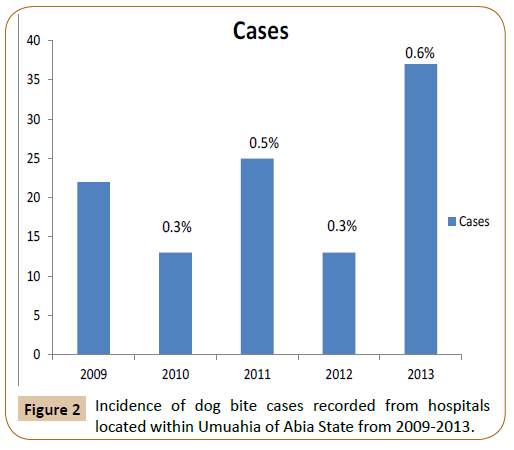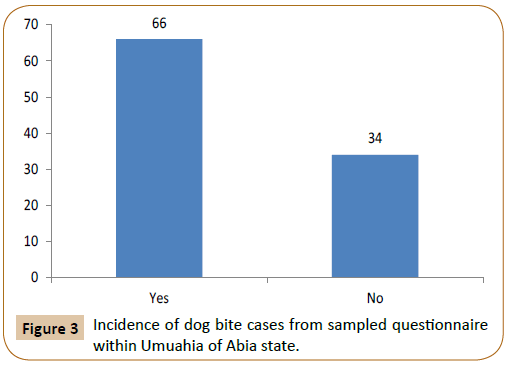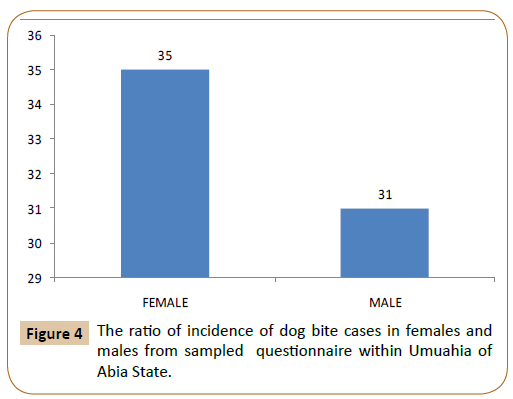Nwoha RIO1* and Ugwuoke FN2
Department of Veterinary Medicine, Michael Okpara University of Agriculture, Umudike, Nigeria
*Corresponding Author:
Nwoha RIO
Department of Veterinary Medicine
Michael Okpara University of Agriculture
Umudike, Nigeria
Tel: 08030987115
E-mail: rosemarynwoha@yahoo.com
Received date: April 18, 2017; Accepted date: May 24, 2017; Published date: June 12, 2017
Citation: Nwoha RIO, Ugwuoke FN.Incidence of Dog Bite Cases in Humans in Umuahia Local Government Area of Abia State. J Vet Med Surg. 2017, 1:2. doi: 10.4172/2574-2868.100012
Keywords
Dogbite; Umuahia; Abia; Nigeria
Introduction
Dog bite is a trauma caused by the teeth of a dog and is usually heavily contaminated with microorganism [1]. It is of great public health concern as most cases of human deaths from rabies have been almost always attributed to dog bite [2]. Globally millions of people are bitten by dogs, for instance in 1994, it was estimated that over 4.7 million dog bites occurred annually in the United States of America and approximately 800,000 persons require medical care, 44% of who are <14 years old [3]. Similarly, a study in Sokoto State, Nigeria, reported 991 dog bite victims within a decade amongst which 11 children died of rabies [4]. Rabies is an acute viral infection of the central nervous system, characterized by irritation of the central nervous system, paralysis and death [5]. In Africa, transmission of rabies virus is principally through the bite of an infected animal especially dogs [6]. In most African countries especially in the Western and Central Africa, there is absence of policy on notification of rabies cases in humans and animals [7]. And this has resulted in inadequate control measure, possibly due to under reporting, lack of follow up on victims of rabid dog bites, lack of information on public health impact of the disease and absence of program for effective vaccination of dogs and control of stray dogs [8]. More so from 2006 to 2008 there were reported problems of low vaccination coverage in dogs and lack of adequate information on the demographic profile of dog bite victims, all these challenges necessitated the study of incidence of dog bite cases and cause in Umuahia of Abia State.
Materials and Methods
Study area
Abia state is located in the southeastern region of Nigeria (Figure 1). It has seventeen Local government areas with Umuahia as the capital of the state. It lies within approximately latitudes 4° 40 i and 6° 4 i and longitudes 7° 10 i and 8° East. The state covers an area of about 5243.7 sq.km which is approximately 5.8 percent of the total land area of Nigeria.

Figure 1: Map of Umuahia.
Study design
At present Umuahia boasts of one federal medical hospital, two state owned hospitals and several private owned hospitals. All the Government owned and seven private owned hospitals were randomly selected in a 5 year retrospective study of dog bite victims in humans. In each of the hospitals, records of existing dog bite cases from 2009-2013 was collated. In addition 100 questionnaires were randomly distributed to hospital staff and patients visited and also within Umudike community which hosts the University. The filled forms were collated same day for analysis. The survey was done twice monthly for 8 months.
Ethical approval
Ethical approval was obtained from Health Research Ethics Committee. Informed consent was obtained from the respondents after been made to understand that participation is voluntary and there is no consequence whatsoever for non-participation or withdrawal at any stage of the study.
Statistical analysis
The result obtained was analyzed with descriptive statistics using SPSS version 16.0. The incidence rate was determined using the formula P=d/n. Where d=the positive cases and n=total number of cases examined [9]. The result was expressed in percentage and shown on a histogram.
Results
In 2009, out of a total of 3900 patients that visited the hospital, 20 were dog bite cases (Table 1 and Figure 2). The year 2010 gave 5259 patients and 14 dog bite cases. In 2011 a total of 5650 patients were recorded and 28 dogs bite cases. In 2012, there were 5526 patients and 19 dog bite cases. The year 2013 gave 6824 patients and 39 dog bite cases. In all out of a total of 27159 patients that visited the hospital from 2009 to 2013, 120 were dog bite cases giving 0.44% retrospective incidence rate. The prevalence rate in dog bite cases in 2009 was at 0.5% and 0.3% in 2010. In 2011 it was 0.5% and 0.3% in 2012. It was 0.6% in 2013. In all a prevalence rate of 0.44% dog bite cases was recorded within 5 years (2009- 2013) of retrospective study. The results from questionnaires were presented on histograms. Figure 3 represents histogram of positive and negative respondents from sampled questionnaires. Out of 100 questionnaires sampled, 66 (66%) were positive for dog bite and 34 (34%) were negative respondents.

Figure 2: Incidence of dog bite cases recorded from hospitals located within Umuahia of Abia State from 2009-2013.

Figure 3: Incidence of dog bite cases from sampled questionnaire within Umuahia of Abia state.
| Year |
Number of patients with other ailment |
Number of dog bite cases |
Total number of patients per year |
Percentage (%) of dog bite cases per year |
| 2009 |
3880 |
20 |
3900 |
0.5 |
| 2010 |
5245 |
14 |
5259 |
0.3 |
| 2011 |
5622 |
28 |
5650 |
0.5 |
| 2012 |
5507 |
19 |
5526 |
0.3 |
| 2013 |
6785 |
39 |
6824 |
0.6 |
| Total |
27039 |
120 |
27159 |
0.44% |
Table 1: Prevalence of dog bite cases presented to the hospital from 2009 to 2013 in Umuahia City of Abia State.
From the questionnaire, dog bite victims reported no knowledge of history of vaccination coverage of dogs. They mostly prefer unorthodox treatment following dog bite. None had knowledge of any rabies patient within their environment. In the Figure 4, out of 66 positive respondents on dog bite cases, a total of 35 (53%) individuals were females while 31 (47%) were males.

Figure 4: The ratio of incidence of dog bite cases in females and males from sampled questionnaire within Umuahia of Abia State.
Discussion
The study observed a fluctuation in incidence rate of dog bite cases as documented in hospitals from 2009 to 2013. The gradual increase in incidence rate from 0.5% in 2009 and 2011 to 0.6% in 2013 somewhat corroborates Kenneth [10] who recorded a high rate of canine homicide in 2013 compared to previous years. This may be attributed to the growing insecurity in Nigeria with increased demand for dog keeping as security but with little or no veterinary care as regards to routine vaccination against zoonotic canine infectious diseases. Most house hold dogs are unvaccinated probably due to lack or inadequate sensitization of dog owners on the dangers associated with such practice or simply borne out of poverty [11]. Most of the bites from vaccinated household dogs are provoked rather than unprovoked bite due to rabies. This supports earlier work done which states that most dog bites are provoked [12,13]. However some of the dog bite cases were perpetrated by unknown dogs which corroborate the findings of Kizer [14].
The incidence rate of dog bite cases from questionnaire recorded at 66% was relatively high compared to 0.44% incidence from hospital data. It shows that greater percentage of patients with various disease conditions are not presented to the hospitals and not recorded for reference purposes which is particularly useful in disease surveillance. This poses big challenge in obtaining reliable data on various conditions shrouded in superstition and folkloric tales such as dog bite cases and rabies. Most victims of dog bite prefer unorthodox treatment and such cases are lost in epidemiological data. The situation is daunting and promotes the use of questionnaires in ascertaining the true epidemiological information in various disease conditions recorded in hospitals. The high incidence rate (53%) of dog bite cases in females compared to males (47%) could be attributed to their vulnerability, small size and sometimes immaturity which induce actions that animal perceive as threatening or aggression [15]. More so in some Nigerian settings, females are marginalized in education and are either sent to hawk, given out in early marriage or sent as househelp thereby exposing them to several dangers including dog bite. The preponderance of female hawkers has been reported in other studies conducted in Nigeria [16,17]. Accordingly, majority of hawkers who do not have any formal education were females who are mostly engaged in hawking [18].
Conclusion
An incidence rate of 0.44% of dog bite cases was recorded in a 5 year retrospective studies in Umuahia of Abia State. The incidence rate from questionnaires was higher in females compared to male. In line with this findings dog owners require sensitization on proper canine vaccination, proper dog restrain and housing to contain the situation.
References
- https://library.berry.edu/title/veterinary-medicine-second-edition/oclc/557353249?ht=edition&referer=di
- Rupprecht CE (2008) Current and Future Trends in The Prevention, Treatment and control of Rabies. Book of Proceedings of National Conference and Workshop on Rabies, IDR ABU Zaria, Nigeria.
- Sacks JJ, Sinclair L, Gilchrist J, Golab GC, Lockwood R (2000) Breeds of dogs involved in fatal human attacks in the United States between 1979 and 1998. J Am Vet Med Assoc 217: 836-840.
- Ahmed H, ChafeUM, Mogaji AA, Abdul Q (2000) A Rabies and dog bite: A decade of experience in Sokoto, Nigeria.Sokoto Journal of Veterinary Science 2: 1-2.
- https://www.tarakharper.com/vrabies.htm
- Oboegbulam JI (1994) Rabies in Man and animal. 1stedn. Fidelity Publishing, Nigeria.
- Dodet B, Adjogoua EV,Dodte B (2008) Fighting rabies in Africa: the Afric Rabies Expert Bureau (AfroREB). Vaccine26:6295-6298.
- Chomel B, Chappuis G, Bullon F, Cardenas E, de Beublain TD, et al. (1988) Mass vaccination campaign against rabies: are dogs correctly protected? The Peruvian experience. Review of Infectious Diseases 4: S697-S702.
- ThrusfieldM (2005)Veterinary Epidemiology. 3rd edn. UK, Blackwell Science Ltd.
- https://dogbitelaw.com/
- Ezeokoli CD, Umoh JU (1987) Epidemiology of rabies in Northern Nigeria. Transactions of the Royal society of Tropical medicine and Hygiene 81: 268-272.
- De KTJ, Lamoureux L, Kahn A (2005) Epidemiology of dog bites: A Belgian experience of canine behavior and public health concerns. The Veterinary Journal 175:482-487.
- Rosado B, Garcia-Belenguer S, Leon M, Palacio J (2008) A comprehensive study of dog bites in Spain, 1995-2004. Vet J 179: 383-391.
- Kizer KW (1979) Epidemiologic and Clinical aspects of animal life injuries. JACEP 8: 34-141.
- Rosenberg NL, Dos ST, Abramo A, Schunk J (1995) Dog bites. Pediatrics Emergency Care11:313-316.
- Fetuga BM,Njokanma FO, Olowu AO (2005) Prevalence,types and demographic features of child labor among school children in Nigeria. BMC Inter Health Human Rights 5:2-8.
- Omokhodion FO,Omokhodion SI (2001) Health problems and other characteristics of Child workers in a market in Ibadan. Africa Journal of Medical Science 30: 81-85.
- Ikwuakam OT, Ibrahim M, Agwam Y (2015) Female Teenagers’ Involvement in Hawking in Katsina State, Nigeria. American J Social Issues and Humanities 5: 588-603.





